|
Thorn
Mountain
|
|
Introduction ~ History ~ By the Year ~ Memories ~ Photo Gallery
|
Thorn
Mountain
|
|
Introduction ~ History ~ By the Year ~ Memories ~ Photo Gallery
Thorn Mountain, located in Jackson, NH, was one of the largest ski areas to close in the state. It featured a vertical of about 850', 2 tandem single chairlifts, 3 rope tows, and 20 trails, along with spectacular views of Mt. Washington. A cable railway was planned but never built. The ski center operated from 1947 until 1956, at which time its chairlifts were condemned and the area folded. Today, it the site is mostly on private property, bisected by roads and homes, though remnants of the area can still be found, if one knows where to look.
NELSAP is grateful to Susan May who has extensively researched Thorn Mountain, and has written the following history of the area!
|
Thorn Mountain Ski Area was opened in the winter of 1948-9 (the same year as Black Mountain) by Charles C. Plumb, a Providence, RI road contractor who thought he could make a lot of money from this “new” sport of skiing. A partner was C. Bird Keach, a Providence lawyer, and together they bought 1200 acres for the upper area and leased 100 acres east of Thorn Hill Road from Ronald Meserve. In the winter of its opening, Thorn advertised “1000 acres of skiing variety”. On Google Earth, the base was at approximately 44°08'35.57”N by 71°10'11-03”W with an elevation of 1034 feet. Halfway could be found at 44°08'42.12” by 71°09'56.41”W. The summit (on Middle Mountain) was 44°08'39.22” by 71°09'26.97” and at about 1881 feet. A now rather astonishing article by Henry Moore in his “DOWN SKI TRAILS” column in the Boston Herald of December 28, 1947 announces that a:
“The cable railway operating on standard gauge track runs from the base to summit of the old Thorn Mountain Slope in two 1211-foot sections with a get-off station at the halfway mark on the flat between the two terrifically steep upper and lower pitches [I think this is what became the parking lot]. “Each section will have two cars seating 30 passengers drawn up and then lowered for the next load by 100 horsepower motors of the type used to kedge the wartime LST's on and off invasion beaches. From the top station of the railway two 500-foot rope tows, one above the other, will carry skiers to the top of more than 400 acres of gently rolling pasture slopes commanding a superb view of the entire Jackson valley west and down the Intervale toward the Conways”.
|
This ad (click on it for the larger version) and story below appeared in the 1948-1949 American Ski Annual, and helps introduce readers to the opening of Thorn: Visitors to Jackson in the Eastern Slope Region of the White Mountains, NH, will be attracted by the new development nearing the first stages of completion on Thorn and Middle Mountains less than 1/2 mile from the center of the village. Looking across the town from Rte. 16 at the western end toward the east one sees the swaths cut up the shoulder of Thorn Mountain and on up to the top of Middle Mt. to accommodate the two chair lifts totaling 4000 feet in length from base to summit. At the right, looking up are the expert trail and intermediate trail totaling 1.25 miles and 1.5 miles respectively, while on the left a 2 mile trail enables the novice to safely negotiate the trip from top to bottom. The vertical drop is 1300 feet. Midway, wide open slopes facing north and west will allow spectators to enjoy the sight of a large number of skiers and ski school classes. Two rope tows are being strategically placed to enable the open field skier and ski classes to enjoy their fun away from advanced skiers. Charles C. Plumb, Sole Owner and Promoter of this Development is president of the CC Plumb Co., Providence, Rhode Island. Mr. Plumb states that these runs are being planned for the tows and chair lifts by Nov. 15 and the whole setup is supposed to be ready by Dec. 1. Of the 1200 acres in the total area 800 will be developed this winter with plans already laid for the expansion next spring of the remaining acreage which covers the north side of Thorn Mountain. Warming and lounging shelters, a restaurant, snack bar, and spectator's shelter at the top of Middle Mt. are scheduled to be ready by the time snow falls with the exception of the top shelter, now planned for completion by the first of the year. "Rink" (Richard E.) Earle, instructor for the past two years in the Jackson Ski School under Arthur Doucette, has been appointed Director of the Thorn Mountain Ski School which will conduct classes daily at the new area. |
|
“From this point to the summit of both Middle Mountain and another several hundred acres of even higher pasture slopes on the saddle between Middle and Thorn. Plumb and Keach are thinking of installing snow cat service.” “As it stands now, the cable railway and the tows will provide almost a full mile of downhill running... If the cat service materializes, skiers will have almost a mile and a half of ride-and-run travel on every type of terrain from novice to super-expert...the development of slopes on the Thorn Mountain peak itself will have to wait another year.” “We toured the whole area today” with “field superintendant, Jack MacPherson (pictured on the right with the Thorn Mountain Mountaineer Snocat) While construction work and the late start, [sic] may keep some of the area unskiable this winter, the upper pasture slopes and the steep lower pitches are certain to offer the type of skiing which Jackson has long sought.”
|
|
The Nov 16, 1947 Carter Notch Clarion says, “The news has just broken around town that a new ski development is contemplated for the Thorn Mountain area.” And further investigative reporting by the Clarion led to a December 7, 1947 article which placed the Base Station “a short distance from Ronald Meserve's saw mill, two identical, parallel lifts will run to the top of the present Thorn Mountain slope”. “Capacity of these lifts will total about 300 persons an hour, taking about six minutes to make the 2200 foot haul”.
A summer in Providence must have tempered these grandiose plans quite a bit. The cable railway never happened. The January 1, 1948 issue of the Clarion announces two chairlifts for Thorn, a new halfway station, etc. Maybe the train story was a ruse... (Jacquie Jones, a former Ski Writer, says that sometimes a completely false story would be sent to a writer for publication!) Yet in the January 17th Clarion in an article on the upcoming Winter carnival, “Skiing events will include jumping, downhill, and slalom of a more or less informal nature, and will be held in the Thorn Mountain Area. If the new cable railway is completed by that time, as it is now hoped, the carnival program will be worked in as part of the official celebration for this, Jackson's newest recreational development.”! And, by the way, it was then snowing profusely—even in Boston and New York!
That winter, rope tows were also operating at Iron Mountain House, Spruce Mountain Lodge, Pinkham Notch (Omer and Flossie Gile's), White Mountain Inn (off Wilson Road) and Oak Lee Ski Lodge (now the Shannon Door).
In the January 25, 1948 Clarion, “The Thorn Mountain Development has been held up for the time being, by a combination of circumstances, including the shortage of freight cars and the trucking strike in Boston. Ties for the cable railway are currently reposing in a Boston freight yard, awaiting high water or something else to move them.” Realize here that articles in the Clarion, written by Dick May, were usually tongue-in-cheek, but mostly truthful.
|
|
By February 22, 1948, three temporary rope tows were in operation at Thorn, from the saw mill 3800 feet up to the Middle Mountain Pastures. One could enjoy the exceptional views while skiing down. (Left-constructing the road and lower portion of the ski area, c1948)
|
| Dick May on one of the ski trails, with the spectacular view of Mt. Washington. |
|
|
|
Freeman Frost of the Jack Frost Shop and Tom Darville of The Thorn Hill Lodge were among the first to use them. “Construction of the cable railway will go ahead as soon as spring weather arrives” and it was expected to be in operation for tourists July 1, 1948. The Jackson Winter Carnival used the cable railway cars on Plumb's trucks to transport the Gorham High School Band. By October, 1948 most chairlift towers and some machinery were in place. [and on a separate part of these mountains, the Rockwells were building their house on 100 acres between Tin and Middle Mountains, the future site of Tin Mountain Conservation Center]. Arthur Doucette and Hannes Schneider advised Plumb on trails which took “18 men and two 16-ton bulldozers”, says Henry Moore. Doucette was also planning to expand his Whitneys' Slope Ski School to both Thorn and Black Mountains.
|
| Thorn's
two single chair lifts were built by Walter Stadig of Soldier Pond, Maine and
Thorn was the first area to open with two consecutive chair lifts.
Right - a view of one of the single chairs, courtesy of Susan May. Walter Stadig has originally designed the chairs to have a piece of rope attached to drag skiers behind each chair, creating a unique hybrid chair-rope tow. However, the idea was quickly abandoned due to steep sections of the chairlift and safety concerns. |
|
|
|
An ad from the “Carter Notch Clarion” shows the following trails: 1. Goff-Novice, 2. Cub-Novice, 3. Porcupine-Intermediate, 4. Springhouse-Intermediate, 5. Bobcat-Expert, 6. Big Birch-Intermediate, 7. Presidential Vista and tow, 8. Otter-1000 feet [tow?], 9. Profile Area and tow, 10. Slalom-1000 feet, T. Thornado (proposed race trail), a parking area and the two chair lifts. In those days there was little difference between Alpine and Nordic skiing, so one could also ski to and from the area. The second season's brochure notes that “It's only ½ mile by ski from many Jackson inns [and a rate sheet is stapled inside] to the base”... That would eliminate the need to drive up the steep road to the parking lot. Left - a skier passes by a boulder on one of the slopes. Note the sign to Christmas Farm Inn, accessible by ski trails.
|
|
In the brief life of Thorn, names of some trails were changed and rope tows moved, so looking at various trail maps does get confusing. Happily, there are photographs and brochures with (handwritten) notes on them. An article entitled “Thorn Ski Pro Corps Includes Actor, Hermit” in the February 26, 1949 issue of “Eastern Skier” lists Thorn's Ski School instructors for its first season as: Director Rink Earle (the actor), Sonny Drown, Jean Mursell, Bob Savard, Mack Beal (the hermit) and Skip Shaw. Also mentioned were three houses located within the ski area that were renting sleeping bag space “for inexpensive lodging”. Houses on the mountain were SUMMER houses and a night in a sleeping bag might have been a cold one! And from another article in the same paper: “Jackson, NH—They've sold a passel of postcards to many a crop of tourists in this tiny mountain village over the years, but now when the woodsmoke first flavors the morning, the customers and half the natives are churning up the scenery that used to be mere backdrop. You can see Mr. Washington's white majesty only six miles away, but half a mile from the village green you can see a lot more. The red metal [and wood] chairs of the Thorn Mt. Lift rise 1110 feet above the town on a 4000-foot ride to the top. This two-sectioned chair lift, designed by Area Operator Charles Plumb, rises from the bottom restaurant-ski-shop building to the base of the upper lift at mid-mountain where the terrain levels off like a staircase landing.” Right - the lower single chairlift climbed a steep slope. Note the wooden towers and the closeness to the ground that the chairs traveled. |
|
|
“Here is the halfway house with snack bar, rest rooms and sun deck. The northern-exposed 900 foot rope tow [“Panorama”] and open slope area lies to the left of the lift. From here to the summit, the vertical rise is slightly steeper. The upper lift ends at a genuine log cabin warming hut that would make Daniel Boone eat his heart out with envy. There are two routes to the bottom for beginners, two variations for experts and two for average to good skiers, all combining stretches of open slopes and trails. To the right of the upper lift and easily reached from the summit there is a 1200 foot rope tow with southern exposed open slope area that joins the mid-station by a stretch of easy road-type running. [Now Tin Mine Road.] On a steep pitch that starts like a chunk of Headwall there's a 1000-foot slalom course to the right of the lower lift section. Everything on the mountain has been erected or cut in less than a year. There is plenty of mountain left for expansion beyond the two proposed trails. One of these, to be called Thornado Racing Trail, will start from the summit of a higher, adjoining peak [THORN Mountain] and curve back to the base. The other will be an average-skier's trail down the left of the upper lift line. Owner Plumb seems to know what he's doing”. Left - a trail map from the early 1950's shows the ski area near full development. Click on the map for the larger version. Note the two sections of single chairlifts, and 2 rope tows at that time. Also note the proposed Thornado Racing Trail coming down from future Tyrol. The Washington Boulder, a large rock that resembles George Washington (accessible today), is located in the central portion of the Goff Area. Some trails had a play on words - like Plumb Line, named after owner C.C. Plumb.
|
Mr Plumb may have known what he was doing, but weather did not cooperate that winter. By January 9, 1949 there was still no snow and an ad was placed in the “Carter Notch Clarion” saying, “WE OFFER CONDOLENCES TO ALL OUR SKIING FRIENDS, THORN MOUNTAIN SKI AREA”. And one from the Jack Frost Ski Shop in Jackson village:
“For
weeks we've been looking for snow
It's the best stuff for running a tow
But to heck with the ski suit
We've a hot little swim suit
And you'll save about twice as much dough.”
A press release from November 15, 1949, names Paula Kahn the Ski School Director. Paula was a member of the 1948 US Olympic Team and in June, 1950 married Paul Valar and went to Franconia. Her staff that year included John MacDonald, Stuart Eynon, and Sonny Drown. All instructors were Certified and rates for lessons were $2.50 for 1 lesson, $4.00 for 2 lessons in one day, and $15.00 for 8 lessons during the season.
Thorn got a lot of publicity that year even though they couldn't open until January. The December 15th issue of “Eastern Skier” featured a picture and article about Jackson School kids having a lesson with Paula Kahn.
| The Eastern Slope Ski Club “Junior Ski Program” has existed in the Eastern Slope/Mount Washington Valley region for over 60 years (www.easternslopeskiclub.org). Through fundraising and hand-me-downs, any child could learn to ski whether their family could afford equipment or not. One afternoon a week, elementary and middle school kids could/can take ski/snow sports lessons in the winter. Usually, classes are taught by parents and other volunteers, and that year, Paula's services were donated by Thorn. We are fortunate that local photographer HC Williams took about 100 photographs of Thorn the first year, including some of Paula and a class of local children (right, click for larger version) |
| During the summer of 1949, the road and parking lot were entirely tarred, so “there should be no more of last year's hub-deep mud.” This could be the first NH ski area to have a paved parking lot! Mr. Plumb WAS a paving contractor after all! Opening date was to be December 15th or earlier. Photos of the paving operations are shown below (click for larger version). | |
The second year saw the opening of a large Novice area called Cozy Canyon with a 500 foot rope tow. It was only a 100 yards from the parking lot and was to be used for slalom. Other improvements for the second season included extending the Porcupine Trail from halfway to the base along the north side of the lower chairlift. The lower section of the Cub Trail was remodeled and other trails widened.
DESCRIPTION OF AREA THEN AND NOW:
One arrived at the ski area by driving from Jackson Village up Thorn Hill Road, taking a left onto what is now called Graustein Way, passing the Meserve Saw Mill on the right and going up a very steep hill into the parking lot. You know you're there today by scraping away leaves underfoot and finding tarmac. (It IS private land!)
As one arrived they would see, from left to right, the base lodge, the ski school meeting place sign, trail map sign, and the chairlift loading building (a very heavily built three-walled building with a green shingled roof) in the center. Under pieces of the “terminal” roof there is what I guess is a fuel tank for the lift and a cement weight in the ground. There are cables on either sides of two trees to hold it down. There was a very wide slope to the right of the chairlift and a smaller, but steep one to the left. It might have been hard for a beginner to imagine riding up and skiing down either of those two, the Hogback and Plummet, respectively. It’s now barely possible to discern the lift line
|
There is another roof under which appears to be a motor. All around is a dump containing Texaco cans, a red steel “box” and cover about 10” x 45” x 12” and a black spare tire cover (locking) from Mr. Plumb's REO (a company started by R. E. Olds in 1905). He left that car in our care during the summer. It had a rumble seat. Trails coming into the base were the QB, Cub, Plumb Line and Hogback. Off to the right past Cozy Canyon was Zeke's Hill. I've been told that my father named many of the trails. This may be true as he had a penchant for puns and word-play. Left - the Cub Trail in a more recent photo. Click for larger version.
|
Through the years staff at Thorn included: Dick May—ski repairman, marketing guy, occasional ski instructor, trail breaker, Jonnie May—office assistant, ticket seller, model, secretary; AND they were parents of this writer. A few others were Ray Abbott, Barry Bryant, Alfred “Bing” Briggs, Zeke Meserve (Roger Orman Meserve) (from Barry Bryant: “Zeke worked at Thorn when it was being built and he was a patrolman part of the time. One of the open slopes was cut that finished at the base and was named for him. Zeke was an excellent skier and was fun to be around.”), George Burgess, Mack Beal, Dick Davis, Ned Gruener, John Pepper, Ron Patch, Barbara Guptill, Alice Breen Hill, Ron Hill, Dick Breen?, David Hayes?, Tink Roberts. Faith Drown and Barbara Guptill worked at the snack bar, as did Nelle Meserve (the one at halfway). Nelle was the daughter-in law of Ronald and Edith Meserve who owned the Sawmill and the Hawthorne Inn—home in the 30’s and 40’s to ski bums including Arthur Doucette of Black Mountain fame. (It burned in the 1970's.)
|
My father had started skiing in 1938 when he was 23. He came to Jackson to visit my uncle, wood craftsman John “Jake” May, and stayed, working in ski shops and skiing till he joined the army's Tenth Mountain Division in 1942. On his return from Italy he continued skiing; working a variety of jobs and helping to build the ski industry in the White Mountains. Many people remember him as “Mr. Wildcat”. My mother had come to Jackson to work as a waitress at Whitneys' Inn, got nicknamed “Jonnie” (on-the-spot) by Bill Whitney and met my father one evening when he and Jake took their parents to dinner. As for her modeling: a photographer and model arrived from Boston to shoot a B&M RR Snow Train poster. The model had a bit too much to drink the night before and didn't make it to the shoot, so my mother was paid $10 to stand in. In fact, many publicity pictures featured locals rather than hired talent in those days. Right - Jonnie May on the Snow Train poster. |
|
|
|
Skiers relax near the top of the upper single chair. |
|
I was about two years old when my parents started taking me to work
with them. I stayed in the base lodge, playing in the sun and keeping out of
the way of ski boots. The base lodge was a cheerful, sunny building that housed
the snack bar in the uphill end, tables, bathrooms and Mr. Plumb’s office behind
the ski repair and ticket counter. There was a Jack Frost Shop in the building
some of the years. There was a deck along the front of the building. This
building was built by Ronald Meserve; belonged to him and since has completely
disappeared indicating that maybe Ronald took it back/tore it down or it was
spirited away by someone else… Right- a view of the base lodge during construction and testing a chair, and the inside of the lodge. |
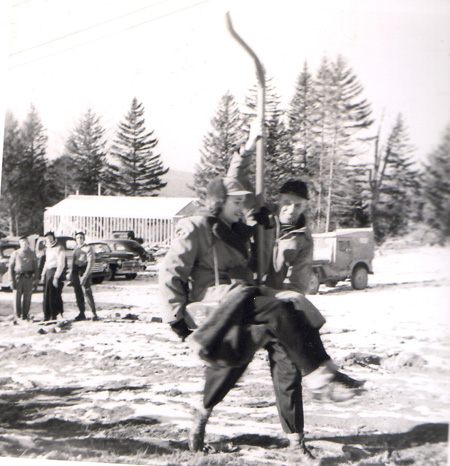 |
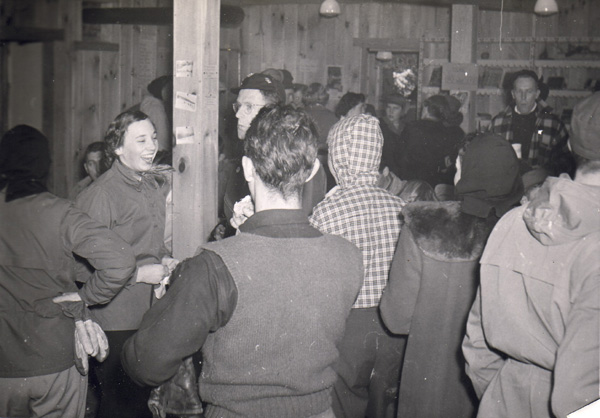 |
|
|
n 2005 sink or stove parts were in the ground as well as a cooking pot.
A septic tank remained as did several pipes and pieces of toilet tanks
in porcelain. There were bottles, beer cans, Milk of Magnesia
bottle parts, one ski binding heel piece and some bits of mirror with
advertising for Abbotts’ Dairy Ice Cream.
Left-this was the site of the base lodge - not much is left, but the septic tank is visible. |
|
Once on the chair, the ride was short to halfway—now buried somewhere
between Juniper Way and Switchback Way. At halfway there was also
a wall-less building used in the summer for clambakes. Here was an
attempt to build a healthy summer business, and having the clambakes at
Halfway provided a reason to charge for a chairlift ride, a fabulous
view and a memorable fresh-air feast. Right - advertisements for the Clam Bake and diners enjoying clams and lobster! According to Jeff Leich, the guy hoisting the lobster is Freeman Frost, “Frostie” who started Jack Frost Shop with his wife Peggy. She is sitting opposite him wearing the striped shirt. |
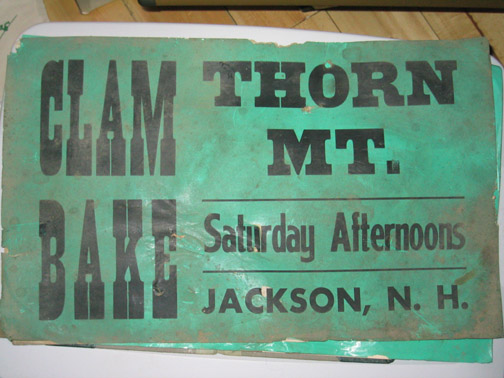 |
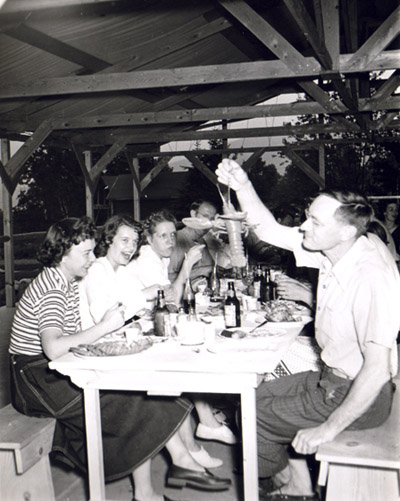 |
|
Apparently, this was enjoyed by both locals and visitors. Mr.
Plumb's right hand man, Jack MacPherson, also from Providence, cooked the clams,
ran the snow grooming machines (Weasels), worked on the road-building and
probably anything else that needed supervision. I've heard that he personally
might have needed supervision, too! Right - the Halfway House and more of the Clam Bake. |
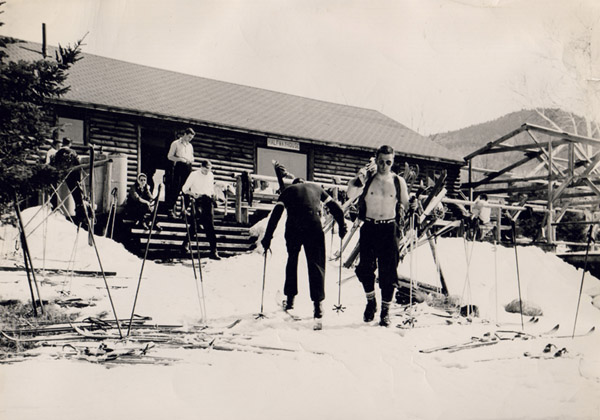 |
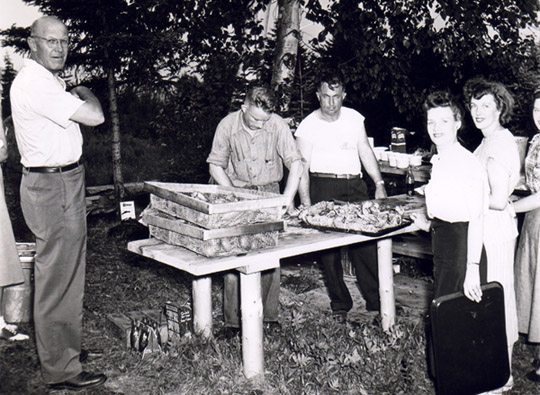 |
|
On October 27, 2008, the founder of this website, Jeremy Davis, Scott
Drake and I went into the woods from Switchback Way, found the base and
walked up the old liftline to Juniper Way where we had left his car. There were
still two lines of cable on the ground and a few of the nuts and bolts that had
held the towers together! With the gouge in the hill we followed the line
exactly.
Right-a view of the Single Chair through the cut - and the exact same view today...note the same rock visible on the embankment on the left! |
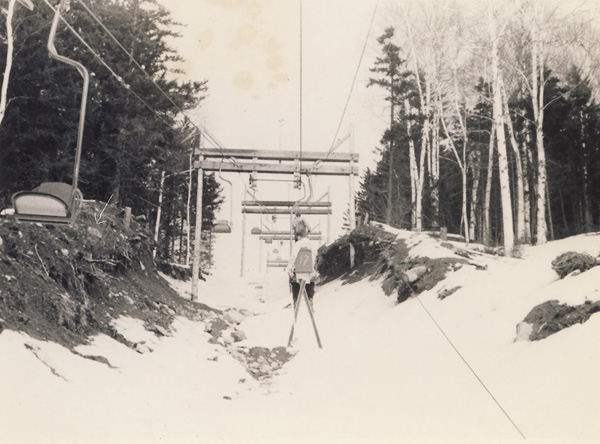 |
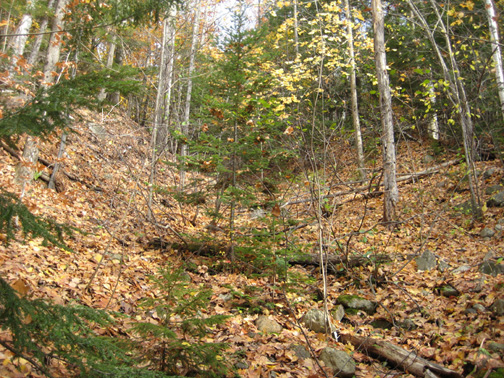 |
|
On Juniper Way there are, in private yards, remains of foundations from Halfway buildings. Happily, there is a very distinctive boulder on the south side of Juniper Way that shows up in several photographs of the Halfway buildings. Right-the upper portion of the lower Single Chairlift and the view today - note the distinctive builder on the left. What a change!
|
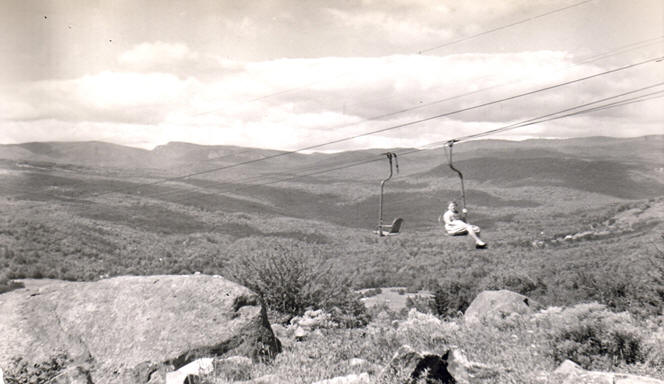 |
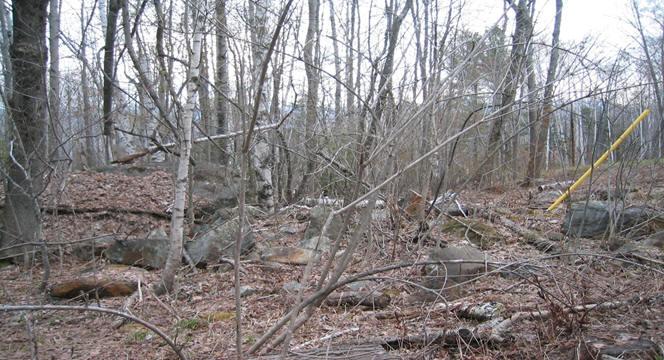 |
|
|
At Halfway the skier would get off the lower chair and board the upper chair. The angle changed and the upper lift went straight up over ledges to the summit. The chairs hung year-round and we used to walk up to Halfway and swing on them. They were rather low to the ground. Someone told me a story about a large woman who insisted/demanded that she ride the chair in the summer even though her weight caused her legs to drag on the ground. The employees were not able to talk her out of it and so attempted to tighten the cable--not very much, apparently--and off she went. She returned with her stockings in shreds and complained to my father who (I hope effectively) barely suppressed a giggle.
|
|
The lift went very close to the Tin Mountain Lodge (once known as the Stone Fox), up across Middle Mtn. Trail to the height of land on Presidential Drive. Right - a view of the single chairlift passing by the Tin Mountain Lodge. |
|
|
|
From there was a trail called the Porcupine going almost directly toward Tin Mountain before veering to the left and paralleling the lift back to Halfway. At the (now) intersection of Switchback Way and Tin Mine Road was a huge field, making it a lovely slope with a rope tow from Switchback Way to Cooper Way. Due to the breathtaking view, it was named the Panorama Slope”. (left) |
|
Thanks to a Mr. Wick who summered here for years, I now know where the bottom of that rope tow was/is in the pines next to Switchback Way. There are simply four posts lashed together across from a driveway. It's easy to see in the winter from the road. I live on the “Goff Area” or “Otter Slope” (a rope tow went “from Washington Boulder just up the ridge on Middle Mountain” Dick May told Tom Eastman in an article for the Mountain Ear) and there is the roof of a toboggan shed just uphill of my property line. (right)
|
|
| If you drive up Tin Mine Road, turn left onto Presidential Road and stop in the middle of the road at its highest point you will be in approximately the place where the chairlift unloaded and where there were the log cabin warming hut and a couple of outhouses (middle photo). These privies still exist in the woods—flat, but recognizable with two holes each. (right photo) |
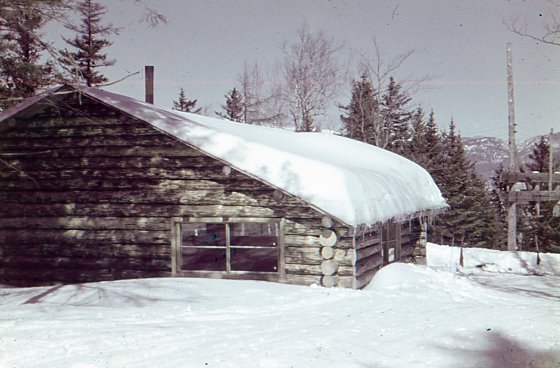 |
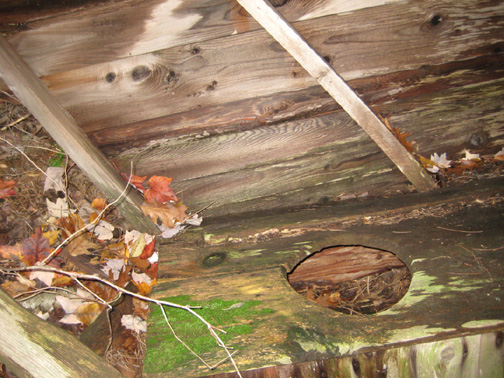 |
|
Taking this in reverse as if skiing down: Presidential Road to Tin Mine Road to Switchback Way and into the woods at the uppermost southerly hairpin turn where there are a lot of blackberry bushes, one would be following the entire two-mile QB trail to the base. I did little skiing at Thorn—at five or so years old I was allowed to ski the QB Trail (named for the Quiet Birdmen—a pilots’ organization to which Mr. Plumb and incidentally, Ray Abbott, Jr. belonged) and once ventured onto the Cub, and into the deep stuff, with embarrassing results. I do remember pushing my way from the summit down the UPPER QB. It was a wide-open mountain—cleared for farming 150 or so years ago and re-cut for skiing. Why didn't Thorn make it? Some say it was the road going to the area and the equally steep trails visible from the base. (With studded snow tires on fresh snow, my car failed to make the hill!) There was no snowmaking to fall back on in those days, with obvious results if there was little snow—especially down south of us, just as it is today. My father said he thought Mr. Plumb just ran out of money. Maybe bigger, new areas that were opening all around New England drew crowds away. At any rate, Thorn closed in about 1956. TYROL Ski Area was built later on THORN Mountain and the chalet houses that came with Tyrol were built along the old QB trail and several new offshoot roads. The ad on the left for Tyrol before construction shows some of the Thorn Mountain trails still visible - it must have been interesting in the early years of Tyrol to drive through more visible remnants of Thorn! |
Jeremy's note - this concludes Susan's write up. I had spoken with Bill Currier, a master lift inspector and incredible wealth of knowledge of New England ski areas about Thorn. He indicated to me that some of the engines and spare parts from the single chairs made their way over to a nascent Mount Whittier, into their T-bars. He also indicated that the chairs at Thorn had become unsafe by the time of the closing in 1956.
| Year | Lifts | Trails | Notes | Source |
| 1947 | Tow | Slope | Area operates with one tow | Susan May |
| 1949 | 1300' lower single chair, 2600' upper single chair. 900' tow, 1200' tow | 1000' long 35 degree slalom hill, expert Bobcat trail (1.5 miles long), expert Big Birch, intermediate Porcupine and Springhouse, 2.5 mile long novice Goff Trail from summit, novice Cub trail. Additional novice and intermediate slopes served by tows. | Season: Dec 15-March 15, Altitude 800-1920', north-northwest exposure, vertical 1100' (based on modern analysis, this was too high). $3.50 per day rate for all lifts. | Where to Ski |
| 1949 | Same | Cozy Canyon area opens, new trail from halfway to base. | Night skiing planned (never happened) | Nashua Telegraph, October 27, 1949 |
| February 22, 1955 | A photo of a skier next to the Washington Boulder is distributed nationwide by the AP | Long Beach, California Independent | ||
| 1956 | Area closes, some engine parts removed to Mount Whittier | Bill Currier | ||
| 1962-1964 | Tyrol is developed, access road slices through old Thorn Mountain Trails | Various sources |
"Limerick" - I am a native of Jackson, NH and I skied at Thorn Mtn. when it was owned by the Charles Plumb family, resulting in the trail called Plumb line, which of course was always in great condition after we all formed a long line to foot pack it. We had so much snow in those days or was it because I was very young..... I was attending school at Jackson Gr. School. Years and years later, when Murray Dearborn developed Tyrol, little did I know that I would be on the Ski School staff under the directorship of Barry Bryant.
Historic Photos
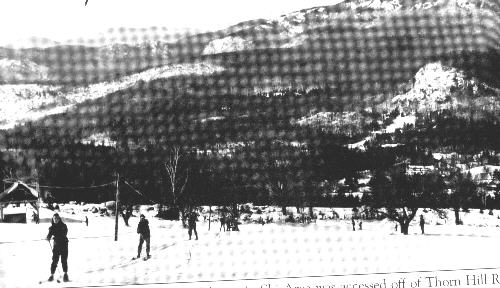 |
 |
| A rope tow at Thorn Mountain, with Iron Mountain House Slope in the background. (Dave Hilton). | Skiers on the Hogback Slope. Lower chairlift building on the right. (Dave Hilton) |
|
|
|
| Halfway House and chairlift. | Likely the QB Trail. |
Recent Photos
| This 1994 Terraserver image shows Thorn Mountain in 1994. Note Profile Drive bisecting the area. Despite being closed for nearly 40 years at this time, outlines of trails and liftlines are still visible. Click for the larger version. |
| Chris Bradford took these photos in 1998, showing the remnants of the base lodge. There is little left today. | 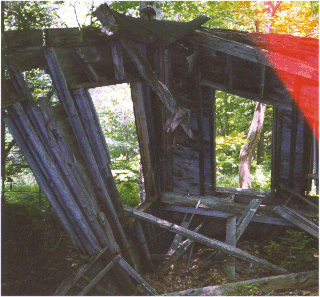 |
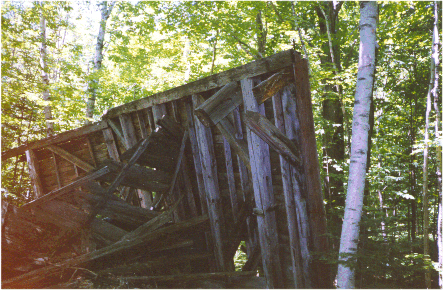 |
| The Washington Boulder stands guard over the Mt. Washington Boulder. Located on the former Goff Slope, this boulder was featured in newspapers nationwide in 1955. Click on the image for the larger version. |
Send your feedback and more memories/photos to nelsap@yahoo.com.
Updated: October 3, 2013